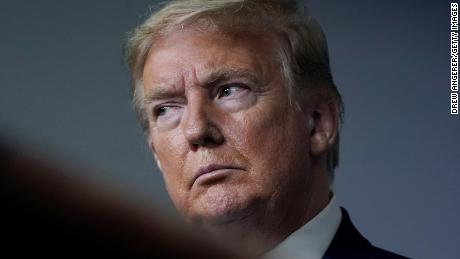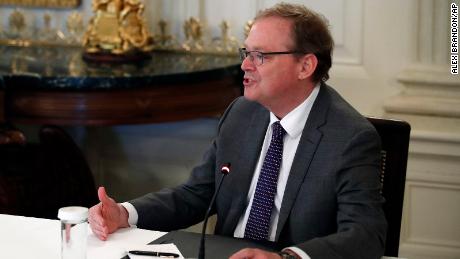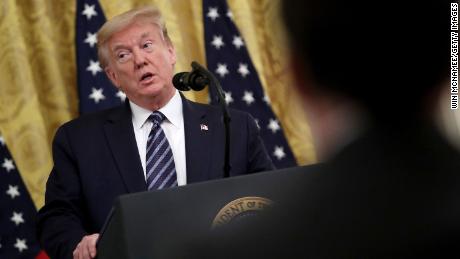Worsening economic data could show the US is in its worst shape since the 1930s because of coronavirus
The emerging reality that the “rocket” like rebound the President predicted is unlikely may be behind Trump’s increasingly frantic statements on a emergency he has also claimed will soon be over.
“We went through the worst attack we’ve ever had on our country,” he said on Wednesday. For weeks early this year, Trump was in denial and painted the threat from the virus as tiny.
“This is really the worst attack we’ve ever had. This is worse than Pearl Harbor. This is worse than the World Trade Center,” Trump said Wednesday.
Economy changes election equation
The worsening economic news will introduce a new dimension into the November presidential election clash between the President and his Democratic challenger, former Vice President Biden.
Trump is already under heavy pressure over his erratic management of the coronavirus pandemic and his initial assurances that a disease that has now infected more than a million people in this country didn’t pose a threat.
The President insisted on Wednesday that he could not be blamed for the virus-related economic plunge and argued that he was the ideal choice to bring the good times rolling back.
“I built the greatest economy — with a lot of great people — that we’ve ever had, and I’m going to rebuild it again,” Trump vowed.
“We’re going to have a great economy very soon. Much sooner than people think. Much sooner.”
Job losses ‘jaw dropping’
The economic damage is almost inconceivable already and it will be laid bare in two sets of what are likely to be awful jobs numbers on Thursday and Friday.
First up is weekly jobs data on initial unemployment claims — the measure that has recorded the terrible toll of weekly layoffs that have now topped 30 million people as the economy has gone into suspended animation.
One of the President’s top economic advisers, Kevin Hassett, has been preparing the country for an unemployment rate of up to 20%. That’s more than 15 percentage points higher than the 50-year lows in the jobless rate that Trump was celebrating just weeks ago.
The desperate economic situation is sharpening the dilemma between public health and the preservation of basic livelihoods that Trump appears to have already resolved.
California Gov. Gavin Newsom, a Democrat, said Wednesday that 4.1 million people have already lost employment in his state.
“The numbers are jaw dropping and it is alarming,” he said.
Trump calls on Americans to be ‘warriors’
Trump is now openly campaigning for the country to open up, despite studies that show tens of thousands of people could die in new outbreaks of the disease.
“We have to be warriors. We can’t keep our country closed down for years,” Trump said. “I think people won’t stand for it, actually. I don’t think our people will stand for it.”
But despite widespread demonstrations by conservative groups against governors who are keeping their states shut down, polls suggest that many Americans are wary of resuming normal life.
Nearly two-thirds of those asked in the Monmouth poll were concerned that states will begin lifting restrictions too quickly. And only 33% share Trump’s implied view that stopping the economy from going into a deep, lengthy downturn is more important than stopping people getting sick.
The initial economic trauma of the shutdowns is likely to be exacerbated by sobering facts on the state of the pandemic. While cases are dipping in worst-hit regions such as New York and New Jersey, they are actually rising in many states yet to peak.
Maybe the US will get lucky and will be spared widespread new pandemic hot zones. But science suggests that states that are now reopening in the absence of robust testing and tracing programs will experience a spike in cases that could cause a second economic shockwave. Given the incubation period of the disease it will several weeks before the impact of eased restrictions begins to show up in serious illnesses.
Many of the states that are getting back to business are nowhere near meeting the 14-day period of consecutive infection rates that are recommended by the White House prior to opening.
In Texas, for instance, where GOP Gov. Greg Abbott has allowed businesses such as restaurants to reopen at much reduced capacity, there were 1,000 new cases of coronavirus reported on Wednesday.
If new infections do emerge on a wider footprint than the previously worst affected areas on the coasts and in the city, the consequences for the economy could be even more serious.
Service jobs in restaurant, leisure, and travel sectors are unlikely to recover when the public is wary about going out.
And rising infections could take another swipe at the health sector which helped drive recent jobs gains but has been hammered in recent months, with elective surgeries and routine appointments canceled.
![]()








